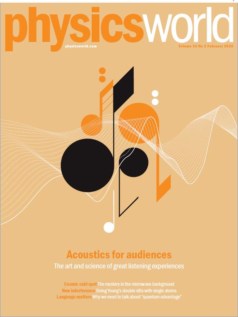
There’s something for everyone in the latest edition of your favourite physics magazine, which is now out in print and digital formats.
The cover feature is fascinating, examining the challenges of creating concert halls and other public venues that have the best possible acoustics for audiences.
That’s a problem that’s been around for years, but how do you deal with venues of historical significance that need to be sensitively refurbished, within a fixed budget while also bringing in new revenue streams, for example via bands or shows in the foyer or otherwise under-used spaces?
Elsewhere in the issue find out about the mystery of the “cosmic cold spot”, new Young’s double slits experiments using the electrons ionized from atoms by lasers, as well as the need to ditch the word “quantum supremacy”.
Remember that if you’re a member of the Institute of Physics, you can read the whole of Physics World magazine every month via our digital apps for iOS, Android and Web browsers. Let us know what you think about the issue on Twitter, Facebook or by e-mailing us at pwld@ioppublishing.org.
For the record, here’s a run-down of the full issue.
• Towards a quantum advantage – Leonie Mueck, Carmen Palacios-Berraquero and Divya M Persaud argue that the term “quantum supremacy” should be replaced in favour of one that is more responsible
• Flying carbon-free – Greta Thunberg crossed the Atlantic on a zero-emission yacht, but how realistic is it to de-carbonize air travel? James McKenzie thinks he has the answer
• Conspiracy theories – As we enter the third decade of the 21st century, why – asks Robert P Crease – do conspiracy theories still abound?
• Sound designs – The refurbishment of public buildings is often more complex than meets the eye. Anna Demming speaks to acousticians and architects about the acoustic considerations behind their designs for public spaces, and some of the tricks to tackle the conflicting demands on these venues
• Double slits with single atoms – Thomas Young’s double-slit experiment is famous for demonstrating the principle of interference. Andrew Murray explains why it’s now possible to carry out an equivalent experiment using lasers that have excited individual rubidium atoms
• The enduring enigma of the cosmic cold spot – Syed Faisal ur Rahman delves into the various explanations for the strange “cold spot” in the cosmic microwave background, the ancient light of the Big Bang, that bathes the universe
• A critical mass of secrets – Margaret Harris reviews Trinity: the Treachery and Pursuit of the Most Dangerous Spy in History by Frank Close
• An uncertain growth – Susan Curtis reviews Growth: From Microorganisms to Megacities by Vaclav Smil
• More questions than answers – Qamar Scott reviews Extraterrestrial Languages by Daniel Oberhaus
• Quantum computing from the ground up – Trapped-ion computing pioneer Chris Monroe describes how decades of experience in academic and government research led him to start his own
quantum computing firm
• Once a physicist – meet Julie Bellingham is an award-winning garden designer based in Oxfordshire, UK
• Getting the film physics right – Sidney Perkowitz on a new breed of independent movie makers



